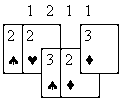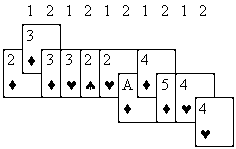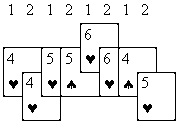Chit Chat
Contributed by Richard Vickery (Richard.Vickery@unsw.edu.au)
Play testers: Alex Filewood, Paul Mackie, Karen Turvey and Eddy Vickery.
Introduction
Chit Chat is a card game for two players that simulates the exchange of small talk between two acquaintances at a social function. Each player has a pet topic and the first player to make a couple of points on their pet topic wins the game. Alternatively if one player lets the conversation lag, then their opponent has won.
Equipment
A special deck of cards is formed from two regular decks to contain the following.
- Two of each card of value Ace (1) through to 6 in three suits (leave out cards from 7 through to Queen plus all Clubs) for a total of 36 "conversation cards".
- 3 Kings - one of each suit without Clubs to be the "pet topic" cards.
The suits are considered to match the following topics:
- Hearts - sport
- Diamonds - economy
- Spades - politics
Deal
Shuffle the conversation cards and deal each player six, put the remainder face down off to one side as the draw pile.
Shuffle the pet topic cards and deal each player one face down, and set the other aside unseen. Each player may look at their own pet topic but must keep it secret from the other player.
Turn the top card of the draw pile and place it next to the draw pile to set the current topic and begin the conversation. Subsequent cards will be played partly overlapping the previously laid card, extending the sequence along the table away from the draw pile. The topic of conversation is the suit of the card closest to the draw pile, and the current topic card is the card of the conversation suit furthest along the sequence away from the draw pile.
Play
Players take alternate turns, beginning with the non-dealer.
A turn consists of two actions performed in order:
- Make one of the three allowable plays.
- Draw one card from the draw pile.
Playing a card
You may freely choose any one of the three allowable plays. If you can not make one of the plays you lose. All plays are made so as to extend the sequence of conversation, with the new card partly overlapping the old. Depending on the play you make, the card will either be in line with the previous card, or else shifted a step towards you.
1. Make small talk. This is done by playing a card
on a different topic (suit not matching current topic card) with a value
no higher than the current topic card. Place your card in line with
the previous one.
However if your opponent made small talk and you follow his small talk
suit (and of course meet the requirement for making small talk that the
card be no higher than the current topic card) then the topic changes.
Discard all cards in the sequence before your opponent's last play, leaving
just the two cards of the same suit. If your card is lower than your
opponent's it is placed in line with it, if you equal or beat his card,
then place your card one step towards you.
2. Continue the argument. This is done by playing a card on the topic (same suit). The new card becomes the current topic card. If your card is equal to or higher than the previous card in the sequence then place your card one step towards you. Note that the card you must beat is not necessarily the topic card, as it might be a small talk card which has value zero and can be beaten by even an Ace. If this is your second consecutive step towards you then you have made a point.
3. Change the topic. This is done by playing two
cards of any value with the same suit (which must be different from the
current topic). Discard all cards in the sequence before your opponent's
last play, leaving just the two cards of the same suit you played.
If you play the higher of your two cards (either if equal) second in the
sequence then you may place it one step towards you.
Changing topic will reduce your hand size by one card as you only draw
one replacement card.
Summary of allowed plays
|
|
|
|
|
|
|
current topic card |
|
|
|
|
|
|
previous card |
|
|
|
|
Does not deny point |
Making a point
You make a point when you have two consecutive steps in your direction, the second one from a "continue the argument" play, and your opponent does not continue the argument with an equal or higher valued card and step the sequence in his direction. Your opponent may change the topic and clear the sequence but this does not deny you your point.
You make a point in your opponent's turn when they declare that they can't block you. You then take the topic card immediately before the current one and put it face up in front of you to indicate that you have made a point on this topic. The sequence is then cleared, leaving only the topic card that won the point, and it is now considered neutral (i.e. not stepped in either direction). Your opponent now has their turn.
If you make a point on your pet topic twice, or make three points on either of the other two topics, then you win the game.
Game end and winning
The game ends when one player wins. This could be because:
- they made two points on their pet topic, or
- they made three points on another topic, or
- because their opponent could not play and let the conversation lag.
When the draw pile runs out, leave the current sequence, and shuffle the discarded cards to form a new draw pile. Cards kept to indicate that the player has made a point do not get shuffled back in.
Example
Richard is player 1, and has the following pet topic and starting hand: 
Karen is player 2, and has the following pet topic and starting hand:

The starting topic is 2 spades, and Richard goes first.
Richard can only make small talk with his 2 hearts or else change topic. He plays 2 hearts. Karen continues the argument in spades by playing her 3 spades which is placed a step towards her. Even the Ace would have caused a step towards her as it follows a small talk play.
Richard is not happy as he has no spades with which to block and no idea whether they are Karen's pet topic. He could small talk in hearts or diamonds using a 3, but instead decides to change topic using the 2 diamonds he drew and his 3 diamonds. This reduces his hand size by one to five.
Before it is cleared the sequence looks as shown in picture a). The top row is number of the player who laid the card, and the draw pile is at the left edge. Richard is sitting towards the top of the page, so a step towards him is shown as a step up.
a)

Diamonds are the new topic, and just the two cards Richard played are kept to start the sequence, the rest are discarded. There follows a sequence of small talk from both players. Attempts by both players to continue the conversation to a point are thwarted. Their small talk then leads to the topic changing to hearts. The sequence before it is cleared looks as follows:
b)

Both players are happy to contest in Hearts. Karen continues the argument, but is blocked by Richard's 5 hearts. Richard follows this with the 6 hearts and will make a point in hearts unless Karen has the other 6 hearts. He could have made the same threat with his Ace hearts, as that would beat Karen's small talk of 5 spades, but it would have been easier for Karen to block. Unfortunately, Karen has the other 6 hearts and so blocks Richard and goes on to make a point in Hearts herself. The 5 hearts she plays is unbeatable as both 6's and the other 5 are already out. As this is Karen's pet topic, just one more point in Hearts will see her chit chat her way to victory! The sequence before clearing looks like this:
c)

Karen keeps the 6 hearts face up in front of her to indicate her point in hearts. The cleared sequence looks as follows in d), and continues with Richard's play:
d)
![]()
We leave the example here....
The sequence of cards drawn for each player was.
Richard:
![]()
Karen:
![]()
Strategy hints
The high and low cards are the key. Aces whittle away at the opponent's hand size because they can force the opponent to change topic. Only another ace or a card of the correct topic can be played on an ace. A pair of sixes can not be beaten, and guarantee that you'll make a point unless your opponent changes topic after your first play.
Changing topic is painful because it reduces hand size and usually costs a card in the topic you want to make a point in. It is best to time this so as to deny your opponent a point, so change after their first "continue the argument" not the second.
Holding high cards (to block) and low cards (to defend your hand) are both important, but are in tension with developing enough power to make a point. This is the fun of the game!
Email Richard Vickery to get a better formatted (and possibly updated) version for your word processor.